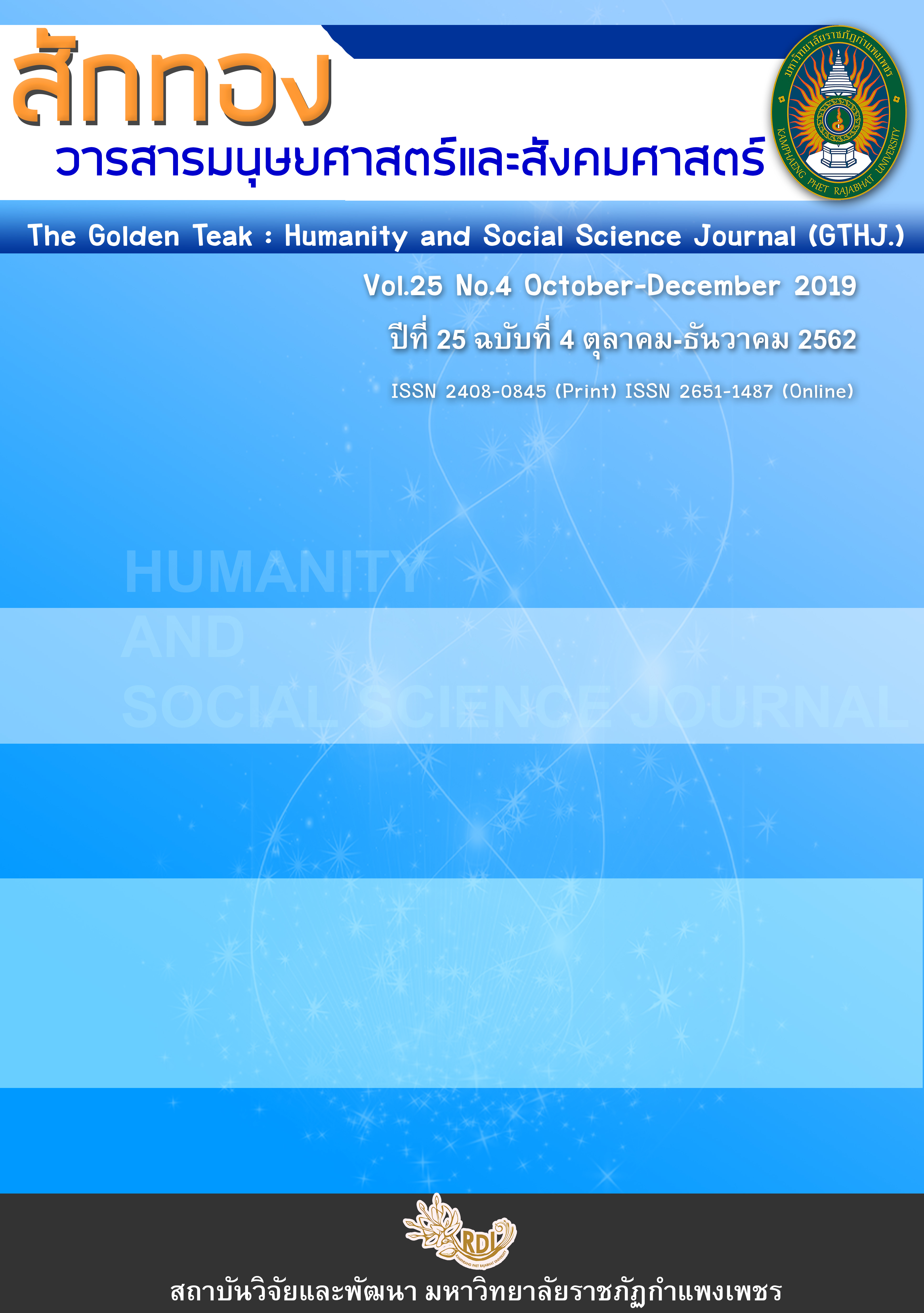Effect of Inquiry Approach Embedded with Peer Instruction on Light and Vision Concepts of Grade 11 Students
Main Article Content
Abstract
This research studies the result of inquiry embedded with peer instruction approach on 36 grade 11 students’ concepts of light and vision at Arunothai Wittayakom School, Chiang Mai. Most students are from different ethnics groups whose Thai is not used as first language. The research tools are; 1) 5 inquiry embedded with peer instruction lesson plans which were verified by several experts in the field, and 2) a light and vision concepts inventory which was validated to be acceptable. The learning engagement was done in the 2nd semester of 2017 academic year and lasted for 20 hours (4 weeks). The analysis of pre-post scores, considering the class average normalized gain (<g>), it indicates that the gain is 0.27 which means that the students’ light and vision concepts were only slightly improved. The engagement needed to be refined in detail for a better result, e.g., to improve teacher-students communication in the engagement with Thai language which seems to be the main obstacle for enhancing ethnic groups students’ concepts.
Article Details
บทความที่ได้รับการตีพิมพ์เป็นลิขสิทธิ์ของวารสาร สักทอง : วารสารมนุษยศาสตร์และสังคมศาสตร์ สถาบันวิจัยและพัฒนา มหาวิทยาลับราชภัฏกำแพงเพชร
ข้อคิดเห็นใดๆ ที่ปรากฎในวารสารเป็นวรรณกรรมของผู้เขียนโดยเฉพาะ ซึ่งมหาวิทยาลัยราชภัฏกำแพงเพชรและบรรณาธิการไม่จำเป็นต้องเห็นด้วย
References
Conceptions of Teaching and Learning Physics and their Classroom Practices during
Student Teaching. Songklanakarin Journal of Social Science and Humanities, 13(4),
595-620.
Buarapan, K. & Singh. (2007). Misconceptions in Force and Motion. Journal of Educational
Criticism, 22(3), 49-63
Chalermchart, S. & Wuttiprom, S. (2015). Effect of Peer Instruction Teaching Method on
Grade 10 Students’ Understanding of Concepts in Force and Motion. Unit of
Research in Science Technology and Environment for Learning Journal, 6(2).
Chanserm, N. (2008). The Results of Constructivist-based POE Approach on the Topic of
Work and Energy Among Grade 10 Students. Thesis of Master’s in Science
Education, Khonkaen University.
Fethestonhaugh, T. & Treagust, D.F. (1992). Students understanding of light and its properties:
teaching to engender conceptual change. Science Education, 76(6), 653-672.
Hundula, C. (2014). A study of Conceptions and Conceptual Change in Light and Vision of
Grade 8 Students Through POE-based Activities. Thesis of Master’s in Education,
Mahasarakam Rajabhat University.
Kaenanee, T. (2013). Science of Teaching: Knowledge for Effective Process of Learning
Management. (17 th ed). Bangkok : Chulalongkorn Press.
Keawkhong, K, Emarat, N. & Arayathanitkul, K. (2010, March). Thai Students' Ideas About an
Image Formed by a Plane Mirror. Siam Physics Congress 2010. Kanchanaburi,
Thailand.
Keokaew, S. (1997). Secondary Level Science Teaching. Prince of Songkla University, Pattani
Campus.
Linder, C. & Erickson, G. (1989). A Study of Tertiary Physics Students' Conceptualization of
Sound. International Journal of Science Education, 11(5), 491-501.
Maleehuan, P. & Suppapittayaporn, D. (2017). The Effect of Peer Instruction Complemented
with Hands-on Physics Activities on the Conception of Force and Motion Of 10th
Grade Students. Nakhon Phanom University Journal, 7(3), 87-95.
Mazur, E. (1997). Peer Instruction : A User’s Manual. New Jersey. USA : Upper Saddle River.
National Institute of Educational Testing Service (Public Organization). (2015). Ordinary
National Education Test Report. [Online]. Available : http://
www.newonetresult.niets.or.th/ExamWeb/FrLogin.aspx?ReturnUrl=%2fExamWeb%2fdefault.aspx [2016, April 20].
National Research Council. (2000). Inquiry and the national science education standards :
A guide for teaching and learning. Washington, D.C. : National Academy Press.
Richard R, Hake. (1998). Interactive-Engagement Versus Traditional Methods: A Six-Thousand-
Student Survey of Mechanics Test Data for Introductory Physics Courses. American
Journal of Physics, 66, (64-74).
Sangpradit, T. (2015). Alternative Conceptions of Students in Physics. Journal of Education
Naresuan University, 202-209.
Sangpradit, T. & Rodranka, W. (2009, April). A Survey for Conceptual Understanding in Light of
Grade 8 Students in Municipal School of Bangkok. Journal of Research Konkaen
University, (4), 310-322.
Sornpimpo, P. & Tanahuang, C. (2014, March). Development of Light and Vision Concepts of
Grade 8 Students Using POE Approach. Journal of Khonkaen University, (15).
Suppapittayaporn, D., Panichpun, B. & Emarat, N. (2010). Can We Trace Arbitrary Rays To
Locate an Image Formed by a Thin Lens, The Physics Teacher, 48, 256-257.
Suppapittayaporn, D., Emarat, N. & Arayathanikul, K. (2010b) The effectiveness of peer
instruction and structured inquiry on conceptual understanding of force and motion :
a case study from Thailand, Research in Science & Technological Education, 28,
63-79.
Wuttiprom, S. (2006). Alternatives for Physics Learning Management for Self-Learning.
[Online]. Available : http://penthai.sc.mahidol.ac.th/html/articles.html
[2006, January 18].


